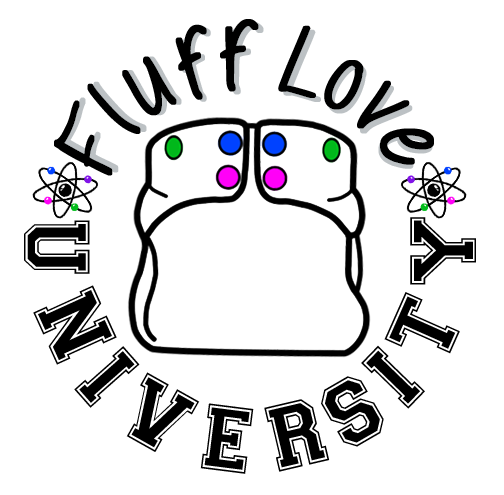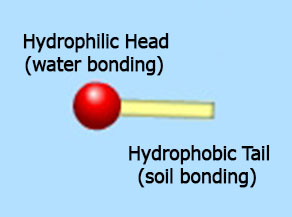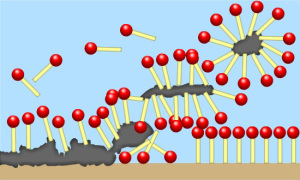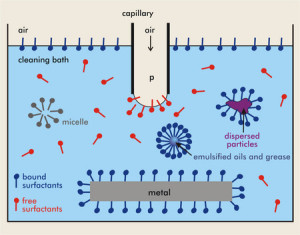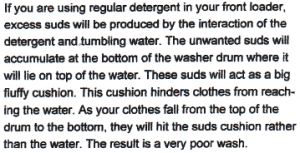Home >> Sourced Science >> Suds and Bubbles
Suds and Bubbles: When and if they are a problem?
by Melinda Wendland
Detergents contain surfactants or surface active agents. Surfactants are molecules that are made up of a head that is hydrophilic (water loving) and a tail that is hydropobic (loves grease and dirt). In the wash, the fecal matter and urine attach to the hydrophobic section of the surfactant and are lifted away with the water by the hydrophilic section. Once they are lifted away with the water, they washed away because they have no receptors left to attach back to fabric.
As mentioned above, the surfactants job is to attach to soil on one end and water on the other, thus pulling soil OUT of fabric and away through the drain holes attached to the water.
Diagram of how soil is attached and suspended in water via surfactant molecules. (Source)
Surfactants cause a reduction in surface tension of the water. “Surface tension is a force present within the surface layer of a liquid that causes the layer to behave as an elastic sheet. It is the force that supports insects that walk on water, for example. Surface tension is caused by the attraction between the molecules of the liquid.” (Source)
Suds or bubbles or “foam is created when the surface tension of water is reduced and air is mixed in, causing bubble formulation.” “When water sprays from a tap in a small basin, you can see bubbles form, but they burst very soon. This is due to the fact that the surface tension of the normal water is high and it tends to draw the water molecules into the main body of the water, to the point where the thickness of the bubble wall is too thin to remain intact and quickly bursts. Instead, the surface tension of the soapy water is much lower: about a third of the pure water, and so the molecules of the bubble are less stressed and it can last longer.” (Source) In simple terms, surfactants reduce the surface tension of the water, which allows bubbles to hang around on the the surface of the water easily. It doesn’t mean there is excess detergent or that all of the detergent is not being removed, it only means it’s easier for bubbles to form and for them to stay intact.
Diagram of surfactants attaching to soil and suspending them in water. Free surfactants are also suspended in water. Agitation and reduction in surface tension create bubbles/suds to form on the surface. (Source)
Softened water allows the formation of bubbles/suds more readily, so having soft water or the addition of a water softener such as Borax or Calgon to your cycles will automatically increase the amount of suds present. The same is true of bleach, it is a mild water softener. In the event of a hard water strip (done with water softeners), followed by a bleach soak (mild water softener), there is a high likelihood of having an increased amount of suds present in the following wash. Softeners being released into the water via the laundry causes this increase.
In a laundry setting, in a TL washing machine, the majority of bubbles/suds are sitting on the surface of the water and are quite literally thrown out during the spin. The reason clothes don’t FEEL sudsy or slimy or soapy even after one rinse is because the suds are not embedded in the fabric, they are removed during the force of the spin and are mostly made up of air. Peeking in your washer during the rinse cycle and seeing suds is no reason to panic, seeing them at that point is NO indication you need additional rinses or that you used too much detergent. During the rinse cycle, any remaining surfactants will attach to the water and be removed as it goes down the drain, BUT during the rinse cycle, some surfactant is still present and therefore surface tension is still reduced so there is still a high propensity for bubbles. There is no need to look in your washer during the cycle, it’s unnecessary and causes unnecessary worry. If your diapers and other laundry don’t feel soapy or slimy when FINISHED, everything is FINE.
There are a couple of instances where suds CAN be a problem. However, they have nothing to do with too much detergent or needing extra rinses and everything to do with what is called a suds cushion. Two things can cause this, using a detergent that is NOT hE formulated or UNDERloading your hE FL washer.
Detergents which are NOT hE formulated:
UNDERloading your hE FL washer:
Too few clothes in a washer can cause an increase in the potential of a suds cushion. In this case, there is not enough fabric moving around to break up and pop the suds produced through friction/tumbling. The suds continue to grow as the cycle progresses and the cushion does not allow proper friction with the sides of the machine and disbursement of soil into the water from the laundry, which results in less than clean laundry. Most hE machines clean most efficiently between ⅔-¾ capacity.
REFERENCES:
- http://www.cleaninginstitute.org/clean_living/soaps__detergents_products__ingredients_2.aspx
- http://www.rsc.org/learn-chemistry/resources/chemistry-in-your-cupboard/finish/6
- http://web.mit.edu/nnf/education/wettability/bubbles.html)
- http://encyclopedia.kids.net.au/page/su/Surface_tension
- http://surface-tension.sita-process.com/dynamic-surface-tension-and-surfactants/
- http://www.kens-applianceservice.com/pdf/HE%20Detergent%20&%20Front%20Loading%20Washers.pdf
Join the discussion on the Fluff Love & CD Science Facebook page!
